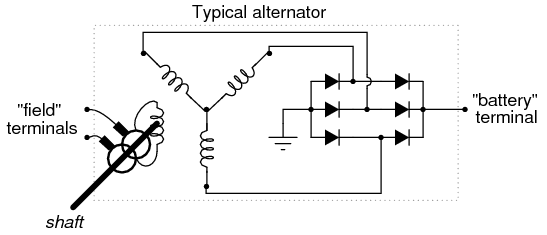This could be a lot of things. Alternator with some bad windings or diodes, and can't keep up. Bad regulator. Bad wiring between the alternator and battery.
So One--At--A--Time
1 See if you can determine that A the alternator can put out a fair amount of amperage, and B that the wiring between the alternator and battery is in fair shape
A Unhook the field connector at the alternator. I assume you have the 69/ earlier charging system, IE the type that came with the car? IF so, you should only have one "push on" connector at the alternator. Unhook this wire, and use a big clip lead to jumper from the alternator push-on field connector to the battery. Bear in mind, to unhook when done testing.
B Hook your voltmeter with clips to the battery, and prop it up so you can see it inside the car. Start the engine, and be careful with the throttle, because if the alternator is healthy, you may "overvoltage" the system.
C Now bring up the RPM and watch the ammeter and voltmeter. This is just a quick and dirty test. The battery, by the way, should be charged up for this test. Bring the RPM up until the voltmeter is showing 15V. The ammeter should be charging some amount. Now turn on everything you can think of, lights, heater, radio/ stereo, 4 way flashers, brake lights. The ammeter should be pegged or nearly so with the voltage at 15V
D IF you cannot achieve this condition, move the voltmeter to the alternator output stud. Bring the RPM up to "about" where you had it previously. Read the voltmeter. If it is SIGNIFICANTLY higher than when hooked to the battery, IE 15V at battery, 17 or higher at alternator, CHECK the wiring between the battery and alternator, and pay PARTICULAR attention to the bulkhead feed-through, and the ammeter connections. Immediately after this test, feel at the alternator stud, the ammeter studs, and around as close as you can to the bulkhead feedthrough, looking for warm/ hot wiring.
IF the voltage between the battery and alternater is nearly the same, IE within 1 or 2 volts, then the wiring is OK but if you cannot get a good charge reading in the above test, you PROBABLY have a defective alternator.
IT IS IMPORTANT to realize that alternators do not just "quit". A 40 A alternator, fer example, with 2 open diodes, is NOT dropped by a third of it's output (6 diodes total) because 2 bad out of 6 diodes causes inefficiency which FURTHER drops the output, probably nearly in half
OK Let's say that the above test was OK, that is, you had a pegged ammeter, and the voltmeter was showing no higher than 16V or so.
This shows that the alternator is most probably OK, and the wiring is also.
NEXT, check the field/ regulator circuit.
Hook everything back up "normal." Turn off the engine. Turn the key to "run" with engine OFF
If you have points ignition, make sure the points are CLOSED. To do that, measure from the coil neg. terminal to the block. IF the voltage is near battery, the points are OPEN. Bump the engine until the voltage goes to a very low value, and move on
Now take your meter and put one probe directly onto the battery positive post, the other probe on the regulator IGN terminal. You are looking for a very low reading, the lower the better. Over .2V (two tenths of a volt) is getting to be too much, 1/2 volt is WAY too much. You are measuring, here, the supply voltage drop from the battery, fuse link, through the bulkhead connector, through the ignition switch connector, the switch, back out the ignition switch connector, and back out the bulkhead connector.
IF THIS VOLTAGE shows a drop, FIX it. Either use the dark blue "ignition run" wire to run a relay and the relay to run the ignition and regulator, or track back and find where the drop is.
Let's say this checked out OK
SO FAR we have showns that the alternator is capable of outputting amperage, and that the regulator IGN supply is OK.
IF THESE CHECKS above show this to be true, replace the regulator.
Make SURE the regulator is grounded.

















